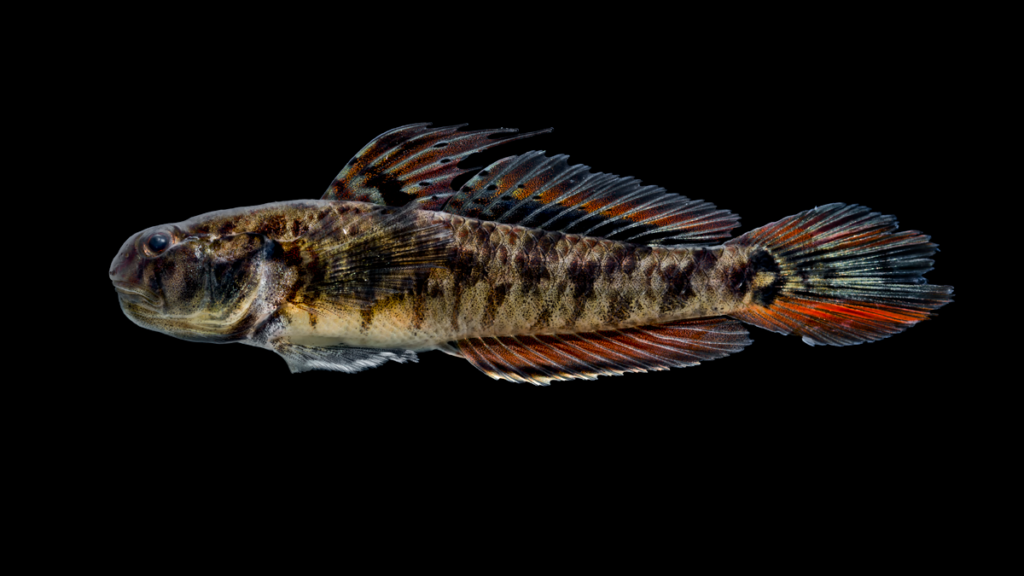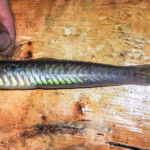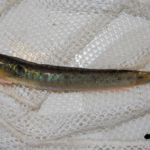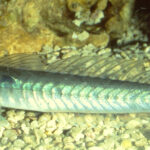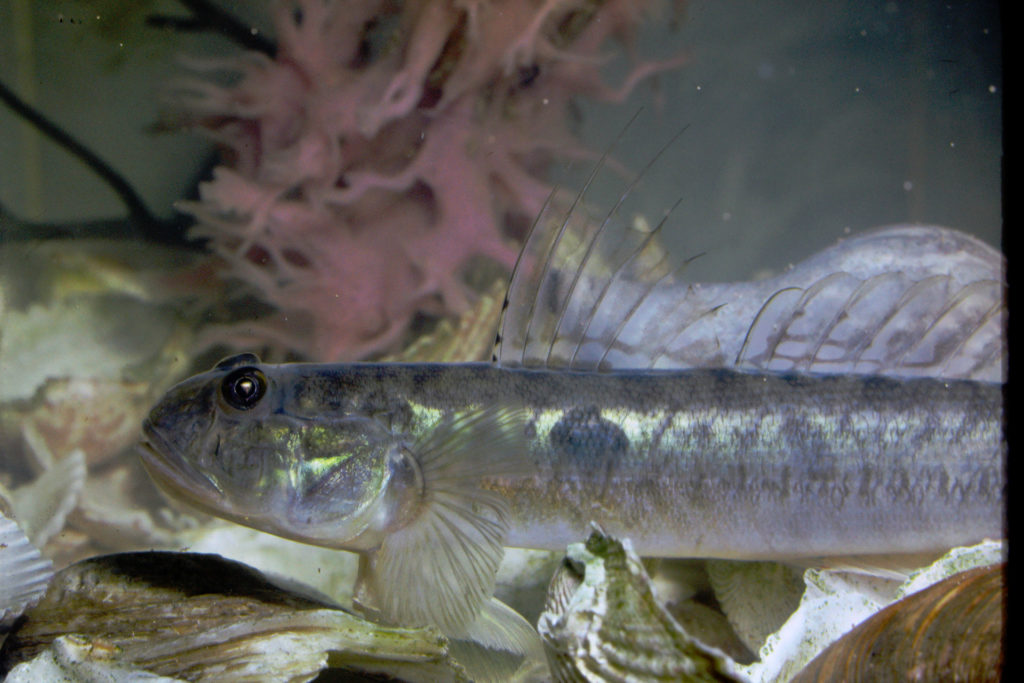
| Family | Scientific Name | Author | Year | Common Name |
| Gobiidae | Gobionellus oceanicus | (Pallas) | 1770 | Highfin Goby |
Gobionellus oceanicus
Unique Characters: Prominent dark spot on trunk below first dorsal fin. Body very elongate. More than 60 lateral scale rows. Dorsal spines threadlike. Pelvic fins completely united to form a round sucking disc. Dorsal fins separated. Upper pectoral-fin rays broadly united. Tongue sometimes slightly indented but not notched. No lobes on shoulder girdle. Body mostly covered with scales. Dorsal fin with usually < seven spines. Pores present in lateral line system on head. Dorsal fins close together. Opercle entirely or partially covered with scales. Posterior tips of pectoral-fin rays not reaching anus. Eye diameter < one-half upper jaw length.
Similar Species:
Sponge Goby
Evermannichthys spongicola
Goldspot Goby
Gnatholepis thompsoni
Sponge Goby Evermannichthys spongicola. Very elongate body naked except for three longitudinal rows of ctenoid scales between posterior end of anal fin and caudal fin base. Body dusky with about 17 irregular dark bars on back. Vertical fins have dark spots. Pelvic fins completely united to form a round sucking disc. Dorsal fins separated. Body stout. No chevron markings on sides. Upper pectoral-fin rays broadly united. Tongue sometimes slightly indented but not notched. No lobes on shoulder girdle. Body scales reduced to only caudal area. Dorsal fin with 5-7 spines. Pores present in lateral line system on head, but sometimes difficult to see or missing. Two dorsal fins widely separated.
Goldspot Goby Gnatholepis thompsoni. Prominent shoulder spot (gold in life). Vertical dark bar from chin through eyes. Body tan with usually many russet-colored spots Snout profile steep. Pelvic fins completely united to form a round sucking disc. Dorsal fins separated. Body stout. No chevron markings on sides. Upper pectoral-fin rays broadly united. Tongue sometimes slightly indented but not notched. No lobes on shoulder girdle. Lateral scales, if present, usually < 57.Body mostly covered with scales. Dorsal fin with usually < seven spines. Pores present in lateral line system on head. Lateral scale rows usually > 29. Body completely covered with scales. Dorsal fins close together. Opercle entirely or partially covered with scales. Fewer than 40 lateral scale rows. Posterior tips of pectoral-fin rays reaching anus. Eye diameter > one-half upper jaw length. Dorsal spines not elongated. No blotches on caudal fin base.
Lyre Goby
Evorthodus lyricus
Bridled Goby
Coryphopterus glaucofraenum
Lyre Goby Evorthodus lyricus. Two distinctive dark, squarish blotches on caudal fin base. Dorsal spines of male very long. Snout very short, rounded. Smudge under first dorsal fin extends into dorsal fin. Pelvic fins completely united to form a round sucking disc. Dorsal fins separated. Body stout. No chevron markings on sides. Upper pectoral-fin rays broadly united. Tongue sometimes slightly indented but not notched. No lobes on shoulder girdle. Lateral scales, if present, usually < 57. Body mostly covered with scales. Dorsal fin with usually < seven spines. Pores present in lateral line system on head. Lateral scale rows usually > 29. Dorsal fins close together. Opercle entirely or partially covered with scales. Fewer than 40 lateral scale rows. Posterior tips of pectoral-fin rays reaching anus. Eye diameter > one-half upper jaw length. No dark trunk spot but shoulder spot present or absent. No shoulder spot. Dorsal spines elongated in mature males.
Bridled Goby Coryphopterus glaucofraenum. Body nearly transparent; prominent black spot above opercle. Barbell-shaped mark at base of caudal fin. A white stripe or “bridle” from upper jaw to preopercle. Pelvic fins completely united to form a round sucking disc. Dorsal fins separated. Body stout. No chevron markings on sides. Upper pectoral-fin rays broadly united. Tongue sometimes slightly indented but not notched. No lobes on shoulder girdle. Lateral scales, if present, usually < 57. Body mostly covered with scales. Dorsal fin with usually < seven spines. Pores present in lateral line system on head. Lateral scale rows usually 25-26. Body completely covered with scales. Dorsal fins close together. Opercle naked. Caudal fin rounded or truncate. Usually < 28 lateral scale rows.
Reference: Ross, S.W., and F.C. Rohde. 2004. The gobioid fishes of North Carolina (Pisces: Gobioidei). Bulletin of Marine Science 74:287-323.
Gallery
